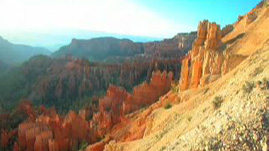Teachers' Domain - Digital Media for the Classroom and Professional Development
User: Preview




In this video a Penn State professor explains “deep time”, which is the notion that the earth is billions of years old, accompanied by visuals of National Park canyons carved out by water and wind. He defines the big processes of geology: physics, chemistry and biology acting on the landscape over deep time. Another professor from Penn State states that the evidence of Earth’s age recorded in rocks is more than sufficient to support Darwin’s theory of evolution.
The 4.55 billion year scale of geologic or deep time is difficult to visualize and comprehend because it is so vast. One analogy to help us grasp the immensity of geologic time is: If Earth’s history went by in one day, human history would flash by in less than a second.
How do scientists know the age of Earth with certainty? Scientists have found evidence in the rocks of earth’s crust and surface that the Earth is ancient. Rocks contain the story of the Earth, just like a book. Although pages may be missing, there is enough of the book left to tell the story.
In the 18th century, a Scottish physician and gentleman farmer James Hutton observed geologic changes taking place on his farm. He hypothesized that the geologic forces changing his farm were no different than processes that had changed Earth in the past. Hutton’s theory of uniformitarianism states that the physical, chemical and biological laws operating today are the same as laws that operated in the past. By studying the present, scientists can understand the past.
Rocks record geological events, such as erosion and the changing life forms of the past, like the fossil of a mammoth. Scientists in the late 1800s and early 1900s first established the relative age of rocks by identifying when they had formed and placing them in sequence, like a calendar. It was not till the early 20th century that scientists had the technology to determine an absolute age for a rock by using radioactive dating techniques.
To determine relative time, geologists rely upon three principles:
Geologists rely on correlation to estimate the age of a large, geographic region by figuring out the age relationships between rocks or geologic events. The widespread presence of fossils in sedimentary rocks has led to the development of the geologic time scale, a sort of calendar of Earth’s history. Geologists assign rocks to the time scale based on fossils they contain, because of the principle of faunal succession. This principle states that fossilized flora and fauna found in sedimentary rock strata succeed one another in a specific, reliable order.
The geologic time scale represents an extensive worldwide fossil record spanning three eras, which are subdivided into periods and divided into epochs. The fossil record supports Darwin’s theory of evolution by providing evidence that different groups of organisms have changed over time, including humans. Millions of types of organisms have evolved, but many others have become extinct.
To explore 4 billion years of life on Earth and discover major transformations, geological changes, and extinction episodes, check out this interactive timeline Deep Time.
To learn more about major milestones in the development of the solar system and Earth, check out this illustrated timeline The Wall of Time.
To learn more about how scientists can choose from many techniques of radiometric dating to determine the age of artifacts as well as the age of Earth itself, check out Radiometric Dating.
 Loading Standards
Loading Standards